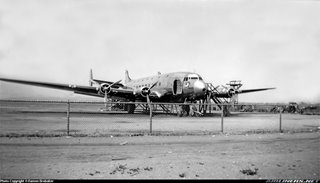
Designed by Committee: The Douglas DC-4E or -4X
MANY OF YOU HAVE PROBABLY HEARD THE OLD maxim that a camel is just "... a horse designed by committee." Well, sometimes, that maxim can be applied to humans, too, including automobile and airplane executives and designers. Many successful companies have been afflicted by groups of well-meaning men who were fundamentally controlled by their diverse needs.
In the early 1930s, Douglas Aircraft, flush with the success of its DC-2 and DC-3 ail-metal airliners, listened to executives who dreamed of transcontinental airliners with twice as many passengers in plush accommodations. Ultimately, the nation's "big four"-American, Eastern, TWA and United-agreed to share the cost of developing an affordable, but superb, multi-engine airliner with double the passenger capacity of the DC-3/DST (which had sleeping berths). But cost, an unreliable engine, size and maintenance loomed as problems.
Engine manufacturer Pratt & Whitney promised a new Twin Hornet engine that would be both powerful and economical. Hamilton Standard and Curtiss promised more efficient propellers (that eventually resulted in a proper constant-speed hydramatic unit). Meanwhile, each airline's design team had its own ideas about the luxurious accommodations, which included bars, pressurization, several lavatory units and dining facilities. Such aircraft would need more crew members to tend to all the passenger accommodations, which ranged from sleeping berths for 30 to recliner seats for up to 52. Also, the vertical stabilizer heights of the new tricycle-gear designs were too high for existing maintenance facilities. Most of the tail-dragger airliners didn't have this problem. That's why Douglas and Lockheed went to a vertical tri-tail. It provided the required surface area, but at a lower height. Lockheed's Kelly Johnson also advocated this design because it had solved the Electra 10's problem of engine-out directional control.
Eventually, the tri-tail prototype DC-4 (sometimes called "DC-4X") appeared bearing a simple "DC-4" designation on the outboard faces of the two outboard fins and the NX18100 license number. It flew proofing flights with all four "sponsor" airlines, but not one approved it for operational activities. The engines were unsatisfactory, and the airliner, in its routine functions, was excessively complicated. TWA bolted; it preferred the new pressurized Boeing 307 Stratoliner, especially because it used many proven components, including the wings and engines of Boeing's B-17D (a military aircraft that was already in service with the Army Air Corps). P&W's Twin Hornet engine proved to be troublesome, so they turned their efforts to developing the R-2000, which was eventually used in the DC-4E.
While this was going on, the Japanese saw an opportunity to gain valuable information about what they considered to be advanced structural technology in large aircraft. They negotiated with certain company executives, including Carl Cover, who had been a test pilot and head of sales at Douglas' Santa Monica, California, headquarters (it had failed to market its DF flying boat and to sell the Navy its XP3D patrol flying boat). The prototype tri-tail DC-4 most likely gained the "E" suffix when it was exported to Japan.
Based on the DC-4E's design, Nakajima was awarded a contract to build four of the long-range bombers under the designation "G5N1" and given the name "Shinzan." Two improved G5N2s were ordered and built, but their performance was disappointing, so the two G5N1s and two G5N2s were converted into transports. All four were redesignated "G52N-L." None of the 138-foot-wingspan Shinzans ever had a central fin and rudder. With the tail turret and a small tailwheel, there was no need for a long skid.
-Warren M. Bodie widewing@dnet.net

0 Comments:
Post a Comment
<< Home